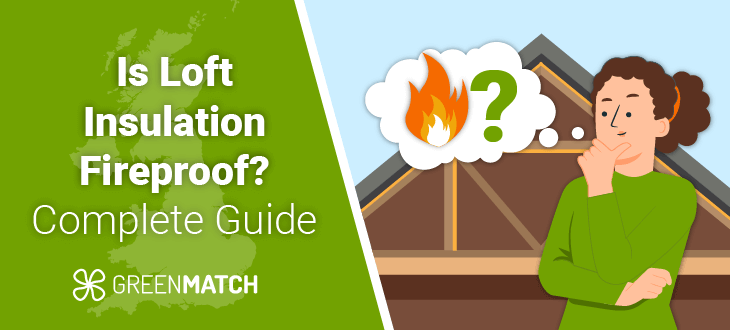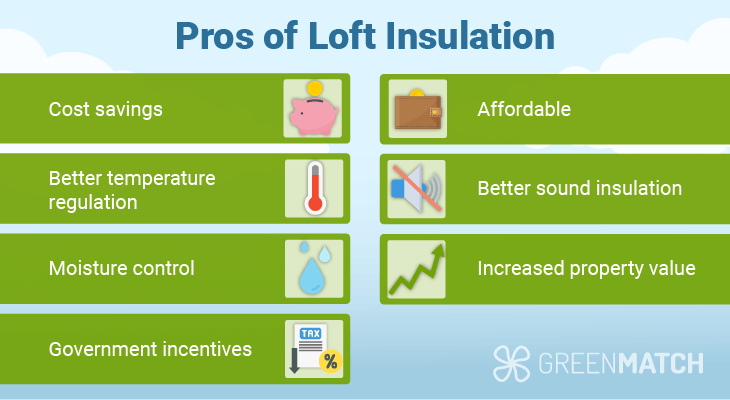Answer these simple questions and we will find you the BEST prices
Which type of solar quotes do you need?
It only takes 30 seconds
100% free with no obligation

Get Free quotes from insulation specialists near you

Save money by comparing quotes and choosing the most competitive offer

The service is 100% free and with no obligation
- GreenMatch
- Insulation
- Loft Insulation
- Fireproof
Is Loft Insulation Fireproof? Complete Guide in 2025


- Loft insulation is typically non-combustible, and modern loft insulation is made of materials such as mineral wool, fibreglass, or sheep’s wool, all of which are non-flammable.
- Loft insulation is generally not dangerous when properly installed and maintained, as modern materials are considered safe for residential use.
- Loft insulation can save up to £340 annually for a detached house and improve home comfort through better temperature regulation. The average installation cost is £930, making it an affordable option.
Loft insulation is crucial for energy efficiency and comfort in homes across the UK. With rising energy costs, homeowners increasingly look for effective ways to reduce their heating bills and carbon footprints. The UK government considers loft insulation an energy-saving material and offers VAT relief for its installation. From April 2022 to 31st March 2027, the installation of loft insulation benefits from a zero rate of VAT, highlighting its role in promoting energy efficiency.
One common concern is loft insulation's fire safety. While not entirely fireproof, the best loft insulation materials are designed to be fire-resistant, offering significant protection. Choosing the right insulation can enhance home safety while providing energy savings and improved comfort. This article will address the process of replacing loft insulation, including loft insulation safety, fire ratings, factors influencing flammability, and whether it suits your UK home.
How can you ensure you choose the right type of loft insulation for your home? At GreenMatch, we connect you with up to 3 vetted insulation specialists to help you decide. By filling out our short form, you can receive tailored quotes from our network of professionals, saving you the hassle of endless research. Our service is free, and you are not obligated to accept any of the quotes you receive. Click the button below to begin!
- Describe your needs
- Get free quotes
- Choose the best offer
It only takes 30 seconds



Is loft insulation fireproof in the UK?
Loft insulation in the UK is generally fire-resistant but not completely fireproof. Here are the key points regarding its fire safety:
- Common Materials: Mineral wool and fibreglass are the most common loft insulation materials. Both are naturally fire-resistant and non-combustible.
- Fire Ratings: These materials typically have an A1 fire rating, meaning they do not contribute to fire spread and are considered non-combustible.
- Euroclass System: The European Reaction to Fire Classification System rates materials from A1 (best) to F (worst). A1-rated materials, like mineral wool, are non-combustible, withstand temperatures over 1000°C, emit minimal smoke, and produce no burning droplets.
- Additional Criteria: The system also evaluates smoke production (s1, s2, s3) and flaming droplets/particles (d0, d1, d2) for materials rated A2 to E.
Smoke Production (s1, s2, s3) measures how much smoke a burning material makes, with s1 being the least and s3 the most. Flaming Droplets/Particles (d0, d1, d2) checks if burning material releases fiery drops that can spread fire, with d0 meaning no drops and d2 the most drops
While mineral wool and fibreglass are highly fire-resistant, they are not entirely fireproof. Proper installation and adherence loft insulation regulations are essential for optimal fire safety. Always consult professionals when installing or upgrading loft insulation.
Loft insulation material fire ratings
The European Reaction to Fire Classification System (Euroclasses) is a standardised method for assessing the fire performance of construction materials across EU member states, including the UK.
Here's a summary:
- Purpose: This classification system aims to provide a unified approach to comparing fire performance of construction products, replacing the range of diverse national methods that existed before.
- Classification: Materials are rated from A1 (best) to F (worst) based on fire performance.
- Key criteria: Some crucial aspects considered for this classification are flashover tendency in a room corner test, smoke production (s1, s2, s3), and flaming droplets/particles (d0, d1, d2).
- Application: Still used in the UK post-Brexit for consistency with EU standards and to facilitate trade.
The Euroclasses standardised testing of materials is crucial in ensuring fire safety during construction and insulation upgrades, including materials for loft insulation.
Here’s a summary of the main fire ratings for the most popular loft insulation materials, raging from A1 (best) to F (worst):

Which factors influence loft insulation flammability?
When considering whether loft conversion insulation is fireproof, it's important to recognise the factors influencing its flammability. Here’s a summary:
- Material composition: The flammability of a material is significantly influenced by the amount of organic materials present and their calorific value, which refers to the heat energy released when the substance burns completely.
- Flashover tendency: Materials are classified based on their likelihood of causing flashover in a room corner test. Classes A1, A2, and B are not expected to cause flashover.
- Temperature resistance: High-quality insulation materials can withstand temperatures over 1000°C without melting.
- Smoke production: For combustible materials (classes A2 to D), smoke release is measured and rated as s1, s2, or s3, with s3 being the worst.
- Flaming droplets/particles: The production of burning droplets or particles is assessed for classes A2 to E, with ratings of d0, d1, or d2 (d2 being the worst).
- Fire growth potential: Materials are classified based on their contribution to fire growth, ranging from "no contribution" (A1) to "significant contribution" (E).
- Organic content: Generally, materials with lower organic content tend to be less flammable. This is why mineral-based insulations like stone wool perform well in fire tests.
Is loft insulation the right choice for your UK home?

How much difference does loft insulation make? Loft insulation is a beneficial choice for UK homes, offering significant advantages in energy efficiency, with potential savings of up to £345 annually for a detached house, with the cost of loft insulation installation being around £930, the availability of loft insulation grants, and CO2 savings of 620 kg per year. This makes it a highly affordable option to improve your home’s energy efficiency and temperature comfort.
Loft insulation improves temperature consistency, reduces noise, and is a long-term investment. Given its benefits and fire-resistant properties, it's highly recommended for UK homes. However, correct installation and compliance with building regulations are essential for optimal efficiency and to prevent any potential risks associated with loft insulation.
For this reason, we highly recommend contacting the best loft insulation installers to get the best insulation guidance for your circumstances.
Already have an idea of what you’re looking for and don’t want to waste any more time? Simply click the button below to get up to 3 of the best insulation quotes. It’s free, and you’re not obligated to accept any of the quotes you receive. Click the button below to begin!
- Describe your needs
- Get free quotes
- Choose the best offer
It only takes 30 seconds



FAQ
Loft insulation materials like mineral wool and fibreglass are generally highly fire-resistant but not completely fireproof.
No insulation material is completely fireproof, but some offer high fire resistance. Mineral wool, for example, achieves the highest fire safety rating (Euroclass A1), making it non-combustible and able to withstand temperatures over 1000°C without melting.
Fibreglass loft insulation is not completely fireproof but is highly fire-resistant. It typically achieves an A1 or A2 Euroclass rating, indicating excellent fire resistance without significant contribution to fire growth.

Alejandro is a copywriter at GreenMatch and is passionate about European environmental policy and renewable energy. He has conducted research on the European Green Deal’s impact on EU energy policy and climate adaptation, and he is committed to using his writing skills to promote sustainable policies.
We strive to connect our customers with the right product and supplier. Would you like to be part of GreenMatch?

